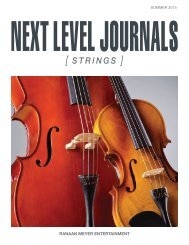Next Level Bassist Musicality Issue
Articles by Sarah Hogan and John Patitucci, Spotlight on the Pittsburgh Symphony, Double Stop Strum by Ranaan Meyer
Articles by Sarah Hogan and John Patitucci, Spotlight on the Pittsburgh Symphony, Double Stop Strum by Ranaan Meyer
You also want an ePaper? Increase the reach of your titles
YUMPU automatically turns print PDFs into web optimized ePapers that Google loves.
The Pittsburgh Symphony Orchestra<br />
Double Bass Section<br />
For classical bass players, there are few pleasures greater than<br />
playing with dedicated and inspiring colleagues. Being able<br />
to surround yourself with great musicians is one of the great<br />
motivations of solitary practice. An amazing bass section can alter the<br />
sound of an entire orchestra. For the first Spotlight column of <strong>Next</strong><br />
<strong>Level</strong> <strong>Bassist</strong>, we’re very excited to recognize the Pittsburgh Symphony<br />
double bass section as one of the strongest and most impressive in the<br />
United States today. We spoke with the regular and substitute members<br />
of the section to get a 360 degree perspective on sitting in with<br />
one of the best bass sections around.<br />
The PSO section is an impressive array of veteran bass players of many<br />
of the nation’s great orchestras. Coming from legendary orchestras like<br />
the Detroit Symphony, Atlanta Symphony, and San Diego Symphony,<br />
every member of the section plays with both strength and wisdom.<br />
According to Principal <strong>Bassist</strong> Jeffrey Turner, “it is a daily privilege to<br />
get to work in a section filled with such wonderful bassists, musicians,<br />
and people. Every single member of our section is an asset<br />
to the orchestra.”<br />
One of the rare advantages possessed by the PSO is its relatively fresh<br />
bass player roster. Since his appointment to the orchestra, Mr. Turner<br />
has been present in the hiring of each other member of the bass<br />
section. Imagine being able to craft your own all-star team of players<br />
based on your experience and the incredible support of a great orchestra!<br />
Having a team made up of highly experienced members in the<br />
peak of their careers is the perfect environment to collaborate.<br />
“We all set good examples for each other,” says Turner. “Working in<br />
our section is one of the great joys of my life.” Section member John<br />
Moore likes to think of it as “driving a very smooth and powerful<br />
sports car.”<br />
It’s easy to hear this in the recent Manfred Honeck Mahler series by<br />
the orchestra, where the bass section shines through extremes of dynamics<br />
and color. “We play big and we play together” is the Pittsburgh<br />
Symphony motto, according to regular substitute Brandon McLean.<br />
“Dynamic range in this group is way beyond that of many other ensembles.”<br />
McLean’s first experience as a substitute underscores one of the unique<br />
qualities of the Pittsburgh Symphony itself. Mclean said his feedback<br />
from the section was “to feel free to play out and get into the sound<br />
of the section a bit more. They weren’t interested in someone coming<br />
in and just hiding within the group. That was after a week in which I<br />
was already convinced that I was playing as big and bold as I possibly<br />
could!”<br />
When you listen to a recording of the orchestra, the bass section has a<br />
presence that is only possible through total unanimity. It was surprising<br />
to find, when asked how they adapted to the playing style of the<br />
section, that each player approached the group with a highly individual<br />
voice. According to Jeff Turner, “I don’t like the word ‘blend.’ It<br />
NOV/DEC 2013 NEXT LEVEL BASSIST<br />
5
















